John Wyndham (1558–1645)
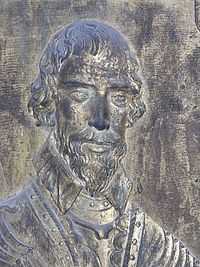
Sir John Wyndham JP (1558–1645) was an English landowner who played an important role in the establishment of defence organisation in the West Country against the threat of Spanish invasion.
Origin
He was born at Orchard Wyndham in Somerset, the son and only child of Sir John Wyndham by Florence Wadham, whose brother Nicholas Wadham and his wife, founded Wadham College, Oxford. His grandfather was Sir John Wyndham (second son of Sir Thomas Wyndham (d. 1521) by his first wife Eleanor Scrope, daughter and heiress of Richard Scrope of Upsall Castle, Yorkshire) who inherited Orchard, Somerset from his wife Elizabeth Sydenham (d. 1 January 1571), daughter and co-heiress of Sir John Sydenham of Orchard, Somerset.[1] He was a minor aged twelve at the death of his father and his wardship and marriage reverted to the crown, Queen Elizabeth I, to be granted to whom she pleased. His grandfather however was able to acquire his wardship which prevented a forced marriage.
Heraldic achievement
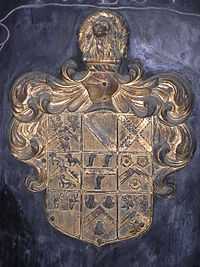
The ancestry of Sir John Wyndham is illustrated by the heraldic achievement shown on his monument in Watchet Church. It consists of a crest: A lion's head erased within a fetterlock or, a crest formerly belonging to the Felbrigg family of Felbrigg, Norfolk, Felbrigg Hall having been the earliest known home of the Wyndham family, and nine quarters as follows:
1st & 9th: Azure, a chevron between 3 lion's heads erased or (Wyndham);
 2nd: Azure, a bend or (Scrope), the paternal arms of his great-grandmother Eleanor Scrope (d. circa 1505), daughter of Sir Richard Scrope (1442–1485) of Upsall Castle, Yorks;
2nd: Azure, a bend or (Scrope), the paternal arms of his great-grandmother Eleanor Scrope (d. circa 1505), daughter of Sir Richard Scrope (1442–1485) of Upsall Castle, Yorks; 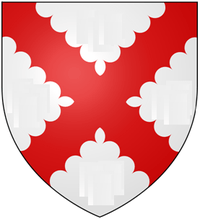 3rd: Argent, a saltire engrailled gules (Tiptoft), the paternal arms of Margaret Tiptoft (d. 1402 or 1431), wife of Roger Scrope, 2nd Baron Scrope of Bolton (1348–1403) (from whom Eleanor Scrope (d. 1505) was 4th in descent) and co-heiress of her father Robert de Tibetot, 3rd Baron Tibetot (d. 1372) of Nettlestead, Suffolk;
3rd: Argent, a saltire engrailled gules (Tiptoft), the paternal arms of Margaret Tiptoft (d. 1402 or 1431), wife of Roger Scrope, 2nd Baron Scrope of Bolton (1348–1403) (from whom Eleanor Scrope (d. 1505) was 4th in descent) and co-heiress of her father Robert de Tibetot, 3rd Baron Tibetot (d. 1372) of Nettlestead, Suffolk; - 4th; Argent, a chevron between 3 rams passant sable a mullet for difference (Sydenham[2] of Orchard);
- 5th: Argent, a fess between three mens' legs couped sable, canting arms of Gambon of Moorstone in the parish of Halberton, Devon.[3] Moorstone was an estate listed in the Domesday Book (1086) and in 1406 the Gambons were licensed by the Bishop of Exeter to have a private chapel in "their mansion of Morston".[4] Substantial remains of the mediaeval manor house survive.[5] Tempore Edward IV (1461–1483) Elizabeth Gambon the heiress of Moorstone, married John Sydenham of Orchard, which eventually brought the estate to the Wyndhams, who still owned it c.1630.[6]
 6th: Gules, a chevron between 3 roses argent (Wadham);
6th: Gules, a chevron between 3 roses argent (Wadham);  7th: Argent, on a chief gules two stag's heads cabosed or (Popham of Huntworth, North Petherton, Somerset
7th: Argent, on a chief gules two stag's heads cabosed or (Popham of Huntworth, North Petherton, Somerset8th: Argent, a chevron sable between three escallops gules (Pollard of King's Nympton, Devon.
Career
Home defence against Spain
He played an important role in the defence organisation of Somerset, the substantial growth of which is shown by the muster in 1580 being 12,000 able footmen, double the total twenty years earlier. The special census of horses taken on 26 August 1583 shows that their number had also increased to forty-seven great horses and 308 light horses. While the defeat of the Spanish Armada saved England from the feared invasion, the significance and value of the defence movement was in keying up the nation and teaching it to realise the heritage it had to defend.
Justice of the Peace
He served as one of the County Justices and as such shared effective responsibility for local government and administration, acting as the representative and general agent of the central government, as well as sitting in quarter sessions.
Civil War
At the start of the Civil War his sympathies appear to have been with the Parliament, which is borne out by a foray made by his cousin Sir Francis Wyndham, 1st Baronet (d. 1676), governor of Dunster Castle, in June 1644 against Orchard Wyndham, as the manor is now known, which resulted in £4,000 worth of plunder being seized for the Royalist cause. Three months after this event he gave £4,000 each for safe keeping to his eighth and ninth sons, Sir Hugh Wyndham and Sir Wadham Wyndham.
Felbrigg inheritance

In 1599 he succeeded to the Felbrigg estate in Norfolk, including Felbrigg Hall, from his father's first cousin Thomas Wyndham (d. 1599), who like his two brothers Sir Roger and Francis (d. 1592), Judge of Common Pleas (whose monument exists in St Peter Mancroft in Norwich) died without issue. Felbrigg was the seat of the senior line of the Wyndham family. In gratitude he placed a marble monument in Felbrigg Church inscibed as follows: Here lieth the body of Thomas Windham, Esq., 3d son of Sir Edmund, who lived a single life and died 20 December 1599 to whose memory Sir John Windham of Orchard in Somersetshire, his cosen and heir, hath set this marble.[7] Sir Edmund Wyndham (d. 1568) was the eldest son of Sir Thomas Wyndham (eldest son of Sir John Wyndham (beheaded 1503 on Tower Hill with James Tyrrell) by his first wife Lady Margaret Howard, 4th daughter of John Howard, 1st Duke of Norfolk (d. 1485)) by his first wife Alianore Scrope, daughter and heiress of Richard Scrope of Upsall, Yorks. Sir John also placed an inscribed marble in Felbrigg Church to Thomas Wyndham's sister Jane Wyndham (d. 1608): Here lyeth the body of Jane Coningsbye, widow, one of the daughters of Sir Edmund Wyndham, knight, first married to John Pope of Oxford, Esq. and after to Hump. Coningsby, Esq. and died without issue 22 November 1608, aged 67, in memory of whom Sir John Windham of Orchard in Somersetshire, her cosin and heir, hath placed this marble. Sir John left the manor of Felbrigg to his 3rd son Thomas.
Marriage & progeny
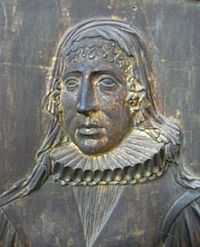
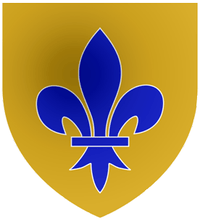
Sir John Wyndham married Joan Portman, daughter of Sir Henry Portman (d. 1590), of Orchard Portman, Somerset, son of Sir William Portman (d. 1557), Lord Chief Justice of England and Wales, by whom he had nine sons and six daughters:
Sons
- Henry Wyndham (1583–1613), eldest son, scholar in civil law, predeceased father. Erected joint mural monument with effigies of himself and his 7th brother George Wyndham (1592–1624), extant in Watchet Church.
- John Wyndham (d. 1649), 2nd son, married Catherine Hopton, daughter of Robert Hopton of Witham, Somerset and sister of Ralph Hopton, 1st Baron Hopton (d. 1652). Their first son was Sir William Wyndham, 1st Baronet (d. 1683), of Orchard.
- Thomas Wyndham (d. 1653), 3rd son, inherited Felbrigg from father; married Elizabeth Lytton, daughter of Sir Rowland Lytton (d. 1615) of Knebworth House, Hertfordshire.
- Humphrey, 6th (?) son.
- George Wyndham (6th son) of Uffords Manor, Cromer, Norfolk, married (1) Anne Godfrey, relict of James Underwood of Uffords Manor, Cromer; (2) Frances Davy daughter of James Davy of Suffield. (See Clearwell, Gloucestershire, for descent of this branch of Wyndham).
- George Wyndham ("senior"), (7th. son[9]), (1592–1624), soldier. Joint mural monument with effigies of himself and his eldest brother Henry Wyndham (1583–1613), extant in Watchet Church.
- Hugh Wyndham (8th son), Baron of the Exchequer, married (1)Jane Wodehouse, daughter of Sir Thomas Wodehouse, 2nd Baronet (d. 1658) of Kimberley, Norfolk; (2)Elizabeth Mynne, daughter of Sir William Mynne (or Minn) (c. 1561–1618) of Woodcote Park, Epsom, Surrey,[10] the widow of Sir Henry Berkeley, 1st Baronet of Wymondham, Leicestershire; (3) Catherine Fleming, daughter of Sir Thomas Fleming (d. 1624) of North Stoneham, Hampshire.
- Sir Wadham Wyndham (9th son), a judge of the King's Bench, married Barbara Clarke, daughter of Sir George Clarke (d. 1689) of Watford Manor, Watford, Northamptonshire, MP for Northamptonshire in 1661.[11] In 1658 he purchased as his seat the manor of Norrington, in Alvediston, near Salisbury, Wiltshire.[12]
Daughters
- Joan Wyndham, married Col. John Giffard (1602–1665) of Brightley in the parish of Chittlehampton, Devon.
- Margaret Wyndham, married John Courtenay (d. 1660) of Molland, Devon, whose mural monument exists in Molland Church.
- Florence Wyndham, married John Harris (d. 1657) of Hayne House, near Stowford, Devon.
- Rachel Wyndham, married Thomas Moore (d. 1695) of Heytesbury, Wiltshire.
- Margery Wyndham, married Thomas Carew of Crowcombe Court, near Watchet, Somerset.
- Anne Wyndham, married Sir John Strode.
- Francis Wyndham (d. 1624), died young.
- Francis Wyndham.
Monument to sons Henry and George
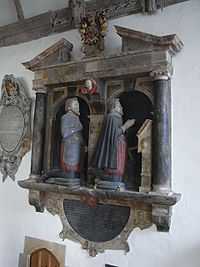
An elaborate mural monument exists high on the north wall of the north aisle of Watchet Church, showing the kneeling effigies of Sir John's 1st and 7th sons Henry (1583–1613) and George (1592–1624), inscribed with the following text:
Hoc saxum effigies refert duorum fratrum Henrici Windham et Georgii senioris quos inter numerosam prolem suscepit Johannes Windham miles e conjuge Joanna filia Henrici Portman militis apud Oxon(iam) gradus academicos obtinuerunt unde translati ille ibi studiis civilibus nec non theologicis gnaviter nimis insudasset apud Orchard decubuit. Hic vero militiae amore incitatus primo instructa classe regia ultra Columnas Herculis contendit. Inde reversus Belgiam petiit ibiq(ue) praefectura brevi potitus inter milites ferventi morbo correptus huisdoni corruit. Ubi necessitati pauperum huius parochiae suppeditare et hoc in sui fratrisq(ue) memoriam extrure propriis sumptibus curavit. Henricus primognitus obiit 9.o Nove(mbris) 1613 an(n)o aetatis 30; Georgius septimogenitus (obiit) 3.o Junii 1624 an(n)o aetatis 32.
Translated as follows:
(“This stone brings back the likenesses of the two brothers Henry Windham and of George senior whom amongst a numerous offspring John Windham, knight, received from his wife Joanna the daughter of Henry Portman, knight. At Oxford they obtained academic degrees whence they transferred, the former to civil studies there, yet no less did he sweat assidiously in theological studies; he laid down to sleep at Orchard. The latter, truly stirred up by love of soldiering, at first with the royal fleet having been prepared, he strove beyond the Columns of Hercules . Returned thence he sought Belgium and there for a short while he obtained a command amongst soldiers; he was seized violently by a fiery disease by which cause he fell to the ground. And at his own expense he took care to supply abundantly to the need of the poor of this parish and to construct this (monument) in memory of himself and of his brother. Henry the first-born died the ninth of November 1613 in the year of his age 30; George the seventh-born died on the 3rd of June 1624 in the year of his age 32.)
Death, burial & monument
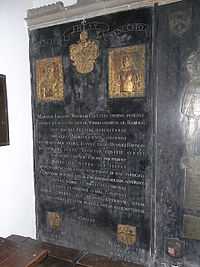
He died on 1 April 1645 and was buried in Watchet Church, Somerset, where exists a memorial to himself and his wife consisting of a large slab of purbeck marble erected vertically against the east wall of the north aisle chapel, containing inlaid plaques of gilt-bronze relief-sculpted portraits and armorial shields, reminiscent of the Renaissance relief-work on the doors of the Baptistry of the Duomo in Florence. It is incised in Roman capitals thus:
Veni Do(m)i(n)e Jhesu Veni Cito; Memoriae Johannis Windham equestri ordine insignis antiqua et illustri gente Windhamiorum de Felbrigg quo gavisus est jure hereditario in agro Norfolcienci oriundi; et charissimae uxoris Joannae filia Henrici Portman de Orchard juxta Taunton equitis aurati. Castissimo conjugio liberos susciperunt masculos novem sex filias. Quinquaginta duos annos continuos in hac parochia S(anc)ti Decumani in aedibus suis de Orchard familiam alverunt. Patriae judicio et populi testimonio pietate et probitate summe conspicui. Horum cineres hic clausi (a)eternum diem et suas animas et suum praestolantur redemptorem. Obiere(nt) ille 1 Apr(ilis) 1645 aetatis suae 87; illa 13 Sep(tembris) 1633 aetatis suae 68.
Translated as:
“Come O Lord Jesus, come quickly. To the memory of John Windham, distinguished by the order of knighthood, from the ancient and illustrious family of Windham of Felbrigg, where he rejoiced in the hereditary right, arisen in the land of Norfolk; and of his most dear wife Joanna the daughter of Henry Portman of Orchard near Taunton, golden knight. By a most chaste marriage they received nine male children, six daughters. During fifty-two continuous years in this parish of Saint Decuman in his house of Orchard they raised their family. By the judgement of his country and by the testimony of the people (he was) conspicuous in the highest piety and probity. The ashes of these were closed up here into eternal day and their souls await their Redeemer. They departed: he, the 1st of April 1645, of his age 87; she, on the 13th of September 1633, of her age 68”.
See also
Sources
- Wyndham, the Hon H A, A Family History, The Wyndhams of Norfolk and Somerset, 1939.
- Wyndham, the Hon H A, A Family History, The Wyndhams of Somerset, Sussex and Wiltshire, 1950.
- Collinson, John, History of Somerset, Vol.3, pp. 486–496
References
- ↑ Blomefield, op.cit. is in error as he does not derive the Orchard family from Eleanor Scrope, which ancestry is clearly shown in the heraldry in Watchet Church. He erroneously states John Windham (the husband of Elizabeth Sydenham) to be the younger brother of Sir Thomas Windham (d. 1521), therefore the brother-in-law, not son, of Eleanor Scrope
- ↑ Robson, Thomas, The British Herald, "Sydenham of Langford, Som."
- ↑ Pole, Sir William (d.1635), Collections Towards a Description of the County of Devon, Sir John-William de la Pole (ed.), London, 1791, p.484
- ↑ Hoskins, W.G., A New Survey of England: Devon, London, 1959 (first published 1954), p.402
- ↑ Pevsner, Nikolaus & Cherry, Bridget, The Buildings of England: Devon, London, 2004, p.467
- ↑ Pole, p.197
- ↑ Blomefield, Francis, An essay Towards a Topographical History of the County of Norfolk, Vol. 8, North Erpingham Hundred: Felbrigg, pp.107–119
- ↑ Debrett's Peerage, 1968, p.898; Impaled (without tinctures) with Wyndham in Watchet Church, Somerset, 1645
- ↑ Stated to be seventh-born (septimogenitus) and Georgi(us) senior on his monument at Watchet
- ↑ A pedigree of Mynne in relation to the manor of Horton, of which Woodecote was a sub-manor, may be found in Manning and Bray's History of Surrey; See also
- ↑ History of Parliament Trust, House of Commons, Members 1660–1690
- ↑ Burke's Landed Gentry, 1937, p.2511, pedigree of Wyndham
External links
- thepeerage.com, Wyndham